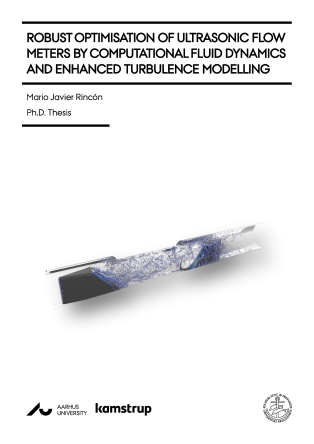Robust Optimisation of Ultrasonic Flow Meters by Computational Fluid Dynamics and Enhanced Turbulence Modelling
Keywords:
Turbulence, Computational Fluid Dyanmics, Optimisation, Experimental Validation, Kriging, Bayesian Optimisation, Fluid Mechanics, CFD, Data-driven, Turbulence Modelling, RANSSynopsis
The accurate measurement of fluid flow is essential in a wide range of industrial applications. In this regard, ultrasonic flow meters present an accurate and cost-effective solution; however, these systems introduce challenges due to their complex geometry and interaction with fluid flow. Hence, understanding their flow dynamics is paramount in the improvement of their
design and operation. Simultaneously, data-driven turbulence modelling techniques have emerged as promising tools to improve the precision of fluid flow simulations. This doctoral thesis focuses on bridging these two domains by predicting complex flows in ultrasonic flow meters, developing a robust methodology for geometrical optimisation, and enhancing existing Reynolds-averaged Navier-Stokes (RANS) turbulence models with progressive and generalisable data-driven methods.
A methodology based on computational fluid dynamics (CFD) is developed to predict the flow dynamics throughout ultrasonic flow meters by the use of RANS k −ω SST. The method is experimentally validated with laser Doppler velocimetry and pressure drop experiments for the whole dynamic range of operation of these systems. Subsequently, a series of flow simulations are driven by surrogate and Bayesian multi-objective optimisation methods to provide improved geometrical designs. These improved geometries are further optimised by an adjoint-based shape optimisation method that enables the 3-dimensional morphing of the geometry, allowing higher improvement gains which cannot be achieved by traditional engineering ingenuity.
In the realm of data-driven turbulence modelling, two critical aspects take centre stage: generalisability and the consistency of a posteriori results. This thesis addresses these challenges through a systematic approach that combines the CFD-driven optimisation techniques developed for flow meter improvement with a progressive augmentation strategy in the k −ω SST turbulence model. The goal is to improve the prediction of turbulence anisotropybased secondary flows, and flow separation—two common stumbling blocks in fluid flow simulations — without altering the successful law of the wall prediction by the original
model. Two correction terms are carefully defined and introduced in the momentum and specific dissipation rate (ω) transport equations. After extensive numerical verification, the enhanced models exhibit significant improvements in the prediction of secondary flows, boundary-layer detachment and reattachment, and friction coefficients in both training and testing cases, reaffirming their a posteriori reliability and generalisability.
In conclusion, this doctoral thesis presents a robust and cost-efficient methodology to systematically improve the performance of complex engineering systems based on CFD simulations. Additionally, two generalisable methods are developed to enhance turbulence modelling based on data-driven progressive approaches. By addressing challenges related to flow separation and secondary flow predictions in complex geometries together with design and shape optimisation techniques, this research contributes to more accurate fluid flow predictions and simulation-based optimisation; benefiting industries dependent on precise flow measurements and simulations. The synergy between data-driven modelling and complex system optimisation demonstrates the potential for innovative solutions in both turbulence modelling and flow measurement technologies, with broad implications across academic and industrial engineering sectors.
Chapters
-
Introduction and Motivation
-
Turbulent Flow in Ultrasonic Flow MetersTurbulent flow in small-diameter ultrasonic flow meters: A numerical and experimental study
-
Dynamic Range ValidationFlow investigation of two-stand ultrasonic flow meters in a wide dynamic range by numerical and experimental methods
-
Design OptimisationValidating the design optimisation of ultrasonic flow meters using computational fluid dynamics and surrogate modelling
-
Shape OptimisationCFD-aided morphing and design optimisation of ultrasonic flow meters
-
Turbulence Modelling for Secondary FlowsProgressive augmentation of turbulence models for secondary flow prediction by computational fluid dynamics driven surrogate optimisation
-
Turbulence Modelling for Separated FlowsProgressive augmentation of turbulence models for flow separation by multi-case computational fluid dynamics driven surrogate optimisation
-
Final Remarks
-
Epilogue from the Author

